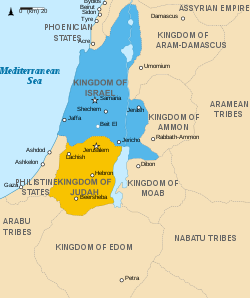যিহূদা রাজ্য
যিহূদা রাজ্য (হিব্রু ভাষায়: מַמְלֶכֶת יְהוּדָה, Mamléḵeṯ Yehudāh; আক্কাদীয়: 𒅀𒌑𒁕𒀀𒀀 Ya'uda; আরামীয়: 𐤁𐤉𐤕𐤃𐤅𐤃 Bēyt Dāwīḏ) ছিল দক্ষিণ লেভান্তের একটি লৌহ যুগীয় রাজ্য। হিব্রু বাইবেল রাজ্যটিকে ইস্রায়েল ও যিহূদা যুক্তরাজ্যের উত্তরসূরি হিসাবে বর্ণনা করে, যেটি ছিল বাইবেলীয় রাজা শৌল, দায়ূদ ও শলোমনের শাসনাধীন দুই ঐতিহাসিক রাজ্য যিহূদা ও ইস্রায়েলের সমন্বয়ে গঠিত যুক্তরাজ্য। তবে ইসরায়েল ফিঙ্কেলস্টাইন ও আলেকজান্ডার ফ্যান্টালকিনসহ অনেক পণ্ডিত মনে করেন যে, খ্রীষ্টপূর্ব ৮ম শতাব্দীর পূর্বে একটি যিহূদা রাজ্যের অস্তিত্বের পক্ষে বিদ্যমান প্রত্নতাত্ত্বিক প্রমাণাদি খুব দুর্বল এবং এই প্রমাণ উদ্ধারে যে পদ্ধতি অবলম্বন করা হয়েছে তা ত্রুটিপূর্ণ।[৪][৫] টেল ড্যান স্টিল দেখান যে এই রাজ্যটি অন্তত খ্রীষ্টপূর্ব মধ্য ৯ম শতাব্দীতে অস্তিত্বশীল থাকার আভাস পাওয়া যায়,[৬][৭][৮] কিন্তু এর ব্যাপ্তি সম্পর্কে কমই ধারণা পাওয়া যায়।
যিহূদা রাজ্য 𐤉𐤄𐤃𐤄 | |||||||||||
|---|---|---|---|---|---|---|---|---|---|---|---|
| ৯৩০ খ্রী.পূ.[১]–৫৮৭/৫৮৬ খ্রী.পূ. | |||||||||||
 খ্রীষ্টপূর্ব ৯ম শতাব্দীতে ইস্রায়েল ও যিহূদা যুক্তরাজ্যের মানচিত্র, ইস্রায়েল রাজ্য নীল রঙে এবং যিহূদা রাজ্য হলুদ রঙে চিহ্নিত। মানচিত্রে প্রদর্শিত প্রতিবেশী রাজ্যসমূহ হল অরাম-দম্মেশক, অম্মোন, মোয়াব, ইদোম ও পলেষ্টিয়া। | |||||||||||
| রাজধানী | হিব্রোণ[২] যিরূশালেম | ||||||||||
| প্রচলিত ভাষা | হিব্রু | ||||||||||
| ধর্ম | একোপাসনাবাদী বা একেশ্বরবাদী ইয়াহ্ওয়েহ্বাদ আদি যিহূদীধর্ম কনানীয় বহুঈশ্বরবাদ মেসোপটোমীয় বহুঈশ্বরবাদ লোকধর্ম[৩] | ||||||||||
| সরকার | রাজতন্ত্র | ||||||||||
| ঐতিহাসিক যুগ | লেভান্তীয় লৌহ যুগ | ||||||||||
• প্রতিষ্ঠা | ৯৩০ খ্রী.পূ.[১] | ||||||||||
| ৫৮৭/৫৮৬ খ্রী.পূ. | |||||||||||
| |||||||||||
| বর্তমানে যার অংশ | |||||||||||
খ্রীষ্টপূর্ব ১ম ও ৯ম শতাব্দীতে যিহূদা অঞ্চল জনবিরল ছিল, কিছু ছোট গ্রামীণ জনবসতি ছিল যার বেশিরভাগই ছিল অরক্ষিত।[৯] যিরূশালেম, রাজ্যটির রাজধানী, সম্ভবত খ্রীষ্টপূর্ব ৮ম শতাব্দীর শেষভাগের আগে একটি গুরুত্বপূর্ণ প্রশাসনিক কেন্দ্র হিসাবে গড়ে ওঠেনি। প্রত্নতাত্ত্বিক প্রমাণ ইঙ্গিত করে যে এর পূর্বে যিহূদার জনসংখ্যা একটি টেকসই রাজ্য টিকিয়ে রাখার পক্ষে ছিল খুবই অপ্রতুল।[১০]
তথ্যসূত্র
সম্পাদনা- ↑
Pioske, Daniel (২০১৫-০২-১১)। "4: David's Jerusalem: The Early 10th Century BCE Part I: An Agrarian Community"। David's Jerusalem: Between Memory and History। Routledge Studies in Religion। 45। Routledge (প্রকাশিত হয় ২০১৫)। পৃষ্ঠা 180। আইএসবিএন 9781317548911। সংগ্রহের তারিখ ২০১৬-০৯-১৭।
[...] the reading of bytdwd as "House of David" has been challenged by those unconvinced of the inscription's allusion to an eponymous David or the kingdom of Judah.
- ↑ https://www.sandiegouniontribune.com/sdut-ml-abrahams-city-timeline-112908-2008nov29-story.html
- ↑ Finkelstein, Israel; Silberman, Neil Asher (২০০১)। The Bible Unearthed: Archaeology's New Vision of Ancient Israel and the Origin of Sacred Texts । The Free Press। পৃষ্ঠা 240–243। আইএসবিএন 978-0743223386।
- ↑ Garfinkel, Yossi; Ganor, Sa'ar; Hasel, Michael (১৯ এপ্রিল ২০১২)। "Journal 124: Khirbat Qeiyafa preliminary report"। Hadashot Arkheologiyot: Excavations and Surveys in Israel। Israel Antiquities Authority। ২৩ জুন ২০১২ তারিখে মূল থেকে আর্কাইভ করা। সংগ্রহের তারিখ ১২ জুন ২০১৮।
- ↑ Finkelstein, Israel; Fantalkin, Alexander (মে ২০১২)। "Khirbet Qeiyafa: an unsensational archaeological and historical interpretation" (পিডিএফ)। Tel Aviv। 39: 38–63। এসটুসিআইডি 161627736। ডিওআই:10.1179/033443512x13226621280507। সংগ্রহের তারিখ ১২ জুন ২০১৮।
- ↑ Grabbe, Lester L. (২০০৭-০৪-২৮)। Ahab Agonistes: The Rise and Fall of the Omri Dynasty (ইংরেজি ভাষায়)। Bloomsbury Publishing USA। আইএসবিএন 9780567251718।
The Tel Dan inscription generated a good deal of debate and a flurry of articles when it first appeared, but it is now widely regarded (a) as genuine and (b) as referring to the Davidic dynasty and the Aramaic kingdom of Damascus.
- ↑ Cline, Eric H. (২০০৯-০৯-২৮)। Biblical Archaeology: A Very Short Introduction (ইংরেজি ভাষায়)। Oxford University Press। আইএসবিএন 9780199711628।
Today, after much further discussion in academic journals, it is accepted by most archaeologists that the inscription is not only genuine but that the reference is indeed to the House of David, thus representing the first allusion found anywhere outside the Bible to the biblical David.
- ↑ Mykytiuk, Lawrence J. (২০০৪-০১-০১)। Identifying Biblical Persons in Northwest Semitic Inscriptions of 1200-539 B.C.E. (ইংরেজি ভাষায়)। Society of Biblical Lit। আইএসবিএন 9781589830622।
Some unfounded accusations of forgery have had little or no effect on the scholarly acceptance of this inscription as genuine.
- ↑ Mazar, Amihai। "Archaeology and the Biblical Narrative: The Case of the United Monarchy"। One God – One Cult – One Nation. Archaeological and Biblical Perspectives, Edited by Reinhard G. Kratz and Hermann Spieckermann in Collaboration with Björn Corzilius and Tanja Pilger, (Beihefte zur Zeitschrift für die Alttestamentliche Wissenschaft 405)। Berlin/ New York: 29–58। সংগ্রহের তারিখ ১২ অক্টোবর ২০১৮।
- ↑ Moore ও Kelle 2011, পৃ. 302।
| হিব্রু বাইবেলের সাথে সম্পর্কিত বিষয়ক এই নিবন্ধটি অসম্পূর্ণ। আপনি চাইলে এটিকে সম্প্রসারিত করে উইকিপিডিয়াকে সাহায্য করতে পারেন। |
